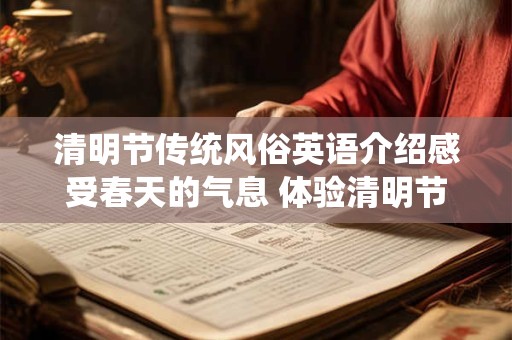As the first breath of spring fills the air, the ancient Chinese festival of Qingming, also known as Tomb-Sweeping Day, unfolds its rich tapestry of traditions and customs. This time-honored celebration not only honors the memory of ancestors but also serves as a bridge between the past and the present, allowing us to immerse ourselves in the vibrant essence of spring.
1. The Arrival of Spring
The onset of spring is a time of renewal and rebirth. The blossoming flowers and the warm sun herald the arrival of this enchanting season. It is during this period that Qingming Festival takes place, symbolizing the balance between life and death, as people pay their respects to their ancestors.
2. Tomb-Sweeping Rituals
One of the most significant customs of Qingming is tomb-sweeping. Families gather to clean and decorate the graves of their departed loved ones. The act of sweeping away dust and debris is a way to show respect and remembrance. As we stand before the tombs, we are reminded of the timeless bond between the living and the dead.
3. Burning Paper Money and Offerings
A common practice during Qingming is the burning of paper money and offerings. This ritual symbolizes the belief that the spirits of the ancestors can receive these offerings in the afterlife. The sight of flames dancing in the breeze and the smoke rising into the sky create a sense of connection to the past.
4. Eating Qingming Zongzi
Zongzi, or sticky rice dumplings, are another traditional food associated with Qingming. These triangular-shaped dumplings are made with sticky rice, bamboo leaves, and various fillings, such as red bean paste, egg, or meat. The act of eating zongzi is a symbol of abundance and prosperity for the deceased.
5. The Qingming Fireworks Display
In some regions, fireworks are set off during Qingming to ward off evil spirits and ensure the safe journey of the ancestors' souls to the afterlife. The brilliant colors and loud explosions create a spectacular sight, as families gather to watch the fireworks together.
6. Qingming Poems and Paintings
Poetry and painting have always been integral to Qingming. During this festival, people write poems and create paintings to express their feelings of sorrow, remembrance, and respect for their ancestors. The art of Qingming reflects the intricate connection between humanity and nature, as well as the enduring spirit of life.
7. The Qingming Picnic
For many families, Qingming is an occasion for a picnic in the countryside. People gather around a table laden with delicious foods, sharing stories and laughter. The picnic symbolizes the unity and togetherness of the family, as well as the celebration of life and its cycle.
8. The Qingming Blossoms
The blooming of flowers during Qingming is a visual representation of the new life that spring brings. Peonies, cherry blossoms, and other flowers are often used to decorate graves and homes, symbolizing purity, prosperity, and the beauty of life.

In conclusion, Qingming Festival is a time to honor our ancestors, celebrate life, and embrace the essence of spring. The customs and traditions of this festival allow us to experience the rich tapestry of Chinese culture and history. As we walk through the blooming gardens, burn paper money, and gather with loved ones, we are reminded of the interconnectedness of life and the beauty of the natural world. Qingming Festival is not just a time for mourning; it is a time to celebrate the enduring spirit of life and the joy it brings.
